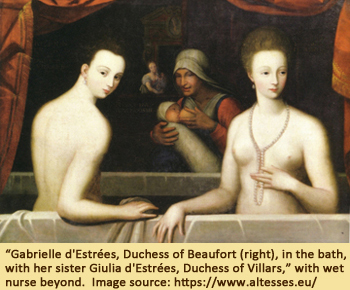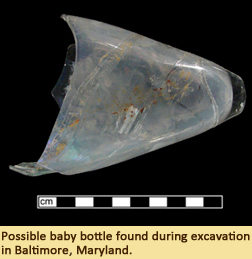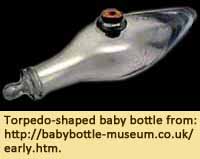Use a Bottle, Save a Breast!
August 2013
By Makenli Essert, MAC Lab Intern
 Ever since the birth of the first human, women have been devising ways to get out of the sole responsibility of breastfeeding their young. After all, it’s time-consuming, can be painful, distracting, and includes leaking, which can be embarrassing. While there are several reasons why some women may be unavailable or unable to breastfeed, such as death, stress, bad health, etc., there are also some women who consider it just too unfashionable or beneath them. Such was the opinion of wealthy European women during the 1600s, where they believed that breastfeeding “spoilt the figure…was noisesome to one’s clothes’…and interfered with gadding about” (Greiner 1998).
Ever since the birth of the first human, women have been devising ways to get out of the sole responsibility of breastfeeding their young. After all, it’s time-consuming, can be painful, distracting, and includes leaking, which can be embarrassing. While there are several reasons why some women may be unavailable or unable to breastfeed, such as death, stress, bad health, etc., there are also some women who consider it just too unfashionable or beneath them. Such was the opinion of wealthy European women during the 1600s, where they believed that breastfeeding “spoilt the figure…was noisesome to one’s clothes’…and interfered with gadding about” (Greiner 1998).
For all these reasons and more, people have created various alternative methods to feeding infants. The most common method during ancient times was to hire a wet-nurse, which was the practice of leaving the infant to another woman for nursing. However,  doctors in later years expressed great criticism of the practice and it rapidly declined in favor, disappearing almost completely by the turn of the 19th century (Greiner 1998). Instead, with the advancement of mass production of glass and ceramics and the greater availability of animal milk, feeding vessels began to be used, even by the wealthy, to store and dispense infant food (Stevens 2009).
doctors in later years expressed great criticism of the practice and it rapidly declined in favor, disappearing almost completely by the turn of the 19th century (Greiner 1998). Instead, with the advancement of mass production of glass and ceramics and the greater availability of animal milk, feeding vessels began to be used, even by the wealthy, to store and dispense infant food (Stevens 2009).
Nineteenth-century baby bottles were used to store either animal milk, or, in conjunction with a breast pump, store the mother’s own milk. Pap-boats on the other hand, contained a soft gruel-like “pap” substance which was often a mixture of bread, flour, water, and sometimes cornmeal and crushed walnuts (Bogucki 2007). The oldest example of such an artificial feeding vessel dates back to more than 4,000 years ago with the discovery of a teacup-shaped earthenware “feeding cup” from Phoenikas, Cyprus (Baby Bottle Museum 2011). Except for size, not a lot has changed in the basic design of these feeding vessels.
 During a 1980 excavation in Baltimore, Maryland, archaeologists found a more recent example of a glass baby bottle dating from around 1850 to 1870. It was unusual because it was a hollow vessel that was unable to be placed vertically on a flat surface, instead laying flat on its side. This shape allowed a baby’s small hands to hold it comfortably on its own so that the mother could leave the child to feed unattended (Stevens 2009). Based on my research, this bottle is most likely a torpedo-shaped baby bottle that would have had two holes: one on the “top” which would be plugged with a cork and where the milk
During a 1980 excavation in Baltimore, Maryland, archaeologists found a more recent example of a glass baby bottle dating from around 1850 to 1870. It was unusual because it was a hollow vessel that was unable to be placed vertically on a flat surface, instead laying flat on its side. This shape allowed a baby’s small hands to hold it comfortably on its own so that the mother could leave the child to feed unattended (Stevens 2009). Based on my research, this bottle is most likely a torpedo-shaped baby bottle that would have had two holes: one on the “top” which would be plugged with a cork and where the milk  would be poured, and another hole at the end of a thin glass bottle neck which would be dubbed “the business end” and have an attached rag, leather piece, or preserved cow teat to act as a nipple for suckling the milk (Baby Bottle Museum 2011). Often there was also a lip on the bottle neck that would flare out, over which a rubber nipple would be stretched (Bogucki 2007). My conclusions about the Baltimore bottle are based on a picture of a similar shaped glass bottle found on a collections website that specializes in early baby feeders.
would be poured, and another hole at the end of a thin glass bottle neck which would be dubbed “the business end” and have an attached rag, leather piece, or preserved cow teat to act as a nipple for suckling the milk (Baby Bottle Museum 2011). Often there was also a lip on the bottle neck that would flare out, over which a rubber nipple would be stretched (Bogucki 2007). My conclusions about the Baltimore bottle are based on a picture of a similar shaped glass bottle found on a collections website that specializes in early baby feeders.